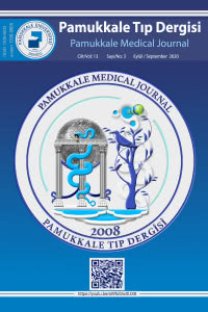Pediatrik yoğun bakım ünitelerinde gözlenen sekonder pankreatitlerin seyri nasıldır?
Çocuk, sekonder pankreatit, pediatrik yoğun bakım ünitesi
What is the course of secondary pancreatitis in pediatric intensive care unit?
Children, secondary pancreatitis, pediatric intensive care unit,
___
- 1- Pant C, Deshpande A, Olyaee M et al. Epidemiology of Acute Pancreatitis in Hospitalized Children in the United States From 2000-2009. PLoS One. 2014; 9: e95552.
- 2- Suzuki M, Sai JK, Shimizu T. Acute pancreatitis in children and adolescents. World J Gastrointest Pathophysiol 2014; 5: 416-26
- 3- Morinville VD, Barmada MM, Lowe ME. Increasing incidence of acute pancreatitis at an American pediatric tertiary care center: is greater awareness among physicians responsible? Pancreas 2010; 39: 5–8.
- 4- Lopez MJ. The changing incidence of acute pancreatitis in children: a single-institution perspective. J Pediatr 2002; 140: 622–4. 5- Cole S, Wakeham M, Werlin S, Goday SP. Classification and Nutrition Management of Acute Pancreatitis in the Pediatric Intensive Care Unit. J Pediatr Gastroenterol Nutr. 2018; 67: 755-9
- 6- Park A, Latif SU, Shah AU, et al. Changing referral trends of acute pancreatitis in children: a 12-year single-center analysis. J Pediatr Gastroenterol Nutr 2009; 49: 316–22.
- 7- Srinath AI, Lowe ME. Pediatric pancreatitis. Pediatr Rev 2013; 34: 79–90.
- 8- Abu-El-Haija M, Kumar S, Szabo F, et al. Classification of acute pancreatitis in the pediatric population: clinical report from the NASPGHAN pancreas committee. J Pediatr Gastroenterol Nutr 2017;64: 984–90.
- 9- Kandula L, Lowe ME. Etiology and outcome of acute pancreatitis in infants and toddlers. J Pediatr 2008; 152: 106–10. 110.
- 10- Werlin SL, Kugathasan S, Frautschy BC. Pancreatitis in children. J Pediatr Gastroenterol Nutr 2003; 37: 591–595.
- 11- Goday PS, Wakeham M, Kuhn EM, Collins MM, Werlin SL. Acute pancreatitis in the pediatric intensive care unit. J Pediatr Gastroenterol Nutr 2015;61: 108–12.
- 12- Sag E, Kaya G, Bahat-Ozdogan E et al. Acute Pancreatitis in Children: A Single Center Experience Over Ten Years. Turk J Pediatr 2018; 60: 153-8.
- 13- Morinville VD, Husain SZ, Bai H, et al.; INSPPIRE Group. Definitions of pediatric pancreatitis and survey of present clinical practices. J Pediatr Gastroenterol Nutr 2012; 55: 261-265.
- 14- Pollack MM, Patel KM, Ruttimann UE. PRISM III: An updated Pediatric Risk of Mortality score. Crit Care Med 1996; 24: 743-52.
- 15- Steingrub JS, Tidswell M, Higgins TL. Hemodynamic consequences of heart-lung interactions. J Intensive Care Med 2003; 18: 92-99.
- 16- Tanaka S, Sagawa S, Miki K, Claybaugh JR, Shiraki K. Changes in muscle sympathetic nerve activity and renal function during positive-pressure breathing in humans. Am J Physiol 1994; 266: 1220-8.
- 17- Manjuck J, Zein J, Carpati C, Astiz M. Clinical significance of increased lipase levels on admission to the ICU. Chest 2005; 127: 246-250.
- 18- Serrano N. Increased lipase plasma levels in ICU patients: when are they critical? Chest 2005; 127: 7-10.
- 19- Mirtallo JM, Forbes A, McClave SA, et al. International consensus guidelines for nutrition therapy in pancreatitis. JPEN J Parenter Enteral Nutr 2012;36:284–91.
- 20- Lodewijkx PJ, Besselink MG, Witteman BJ, et al. Nutrition in acute pancreatitis: a critical review. Expert Rev Gastroenterol Hepatol 2016;10:571–80.
- 21- Abu-El-Haija M, Kumar S, Quiros JA et al. Management of Acute Pancreatitis in the Pediatric Population: A Clinical Report From the North American Society for Pediatric Gastroenterology, Hepatology and Nutrition Pancreas Committee. J Pediatr Gastroenterol Nutr. 2018 Jan;66(1):159-176.
- 22- Carreazo NY, Ugarte K, Bada C. When should we start oral intake in children with severe acute pancreatitis? Evid Based Med 2008;13:4–5.
- 23- Abu-El-Haija M, Wilhelm R, Heinzman C, et al. Early enteral nutrition in children with acute pancreatitis. J Pediatr Gastroenterol Nutr 2016;62:453–6.
- ISSN: 1309-9833
- Yayın Aralığı: Yılda 4 Sayı
- Başlangıç: 2008
- Yayıncı: Prof.Dr.Eylem Değirmenci
Kadri GÖKÇE, Ramazan SABIRLI, Aylin KÖSELER, İbrahim TÜRKÇÜER, Atakan YILMAZ
Sepsisli hastalarda sıvı dengesinin sonuçlara etkisi; üçüncü basamak bir hastane deneyimi
Deniz UYSAL SÖNMEZ, Hulya DİROL, Abdullah ERDOĞAN
Bir Tıp Fakültesi öğrencilerinin meslek seçimini etkileyen faktörler
Sibel ÖNER YALÇIN, Nevzat Atalay ÇELİKYÜREK, Hande ŞENOL, Kamil Fatih TÜRKER, Okan YAVUZ, Mert Can KAYA, Mert BOZDAĞ
Deri döküntüsü ile başvuran iki olgu: COVİD-19 olabilir mi?
Suna Seçil ÖZTÜRK DENİZ, Sevgi ÖZAN, Firuze SOYAK, Şule SUBAŞI GÖKŞİN, Murat KUTLU
Polikistik over sendrom tanılı hastalarda Adropin ve Lipokalin düzeylerinin incelenmesi
Soner GÖK, İ.veysel FENKCİ, Erkan ALATAŞ, Babür KALELİ, Yaşar ENLİ
Eski bir molekül, yeni bir ilaç; intravenöz Fosfomisinin klinik kullanımdaki yeri
Fatih TEMOÇİN, Levent ŞENSOY, Tuba KURUOĞLU, Aynur ATİLLA, Esra TANYEL
Defne GURBUZ, Melis KOŞAR TUNÇ, Semih KARAKETİR, Güler BERKİTEN, Onur AKAN
Dev meningiomlar: 40 olgunun detaylı analizi
Çocuklar için özel gereksinim raporu başvurusu olan olguların özel gereksinim düzeyleri
Merve AKTAŞ TERZİOĞLU, Ahmet BÜBER, Çiğdem TANRIVERDİ, Hande ŞENOL
